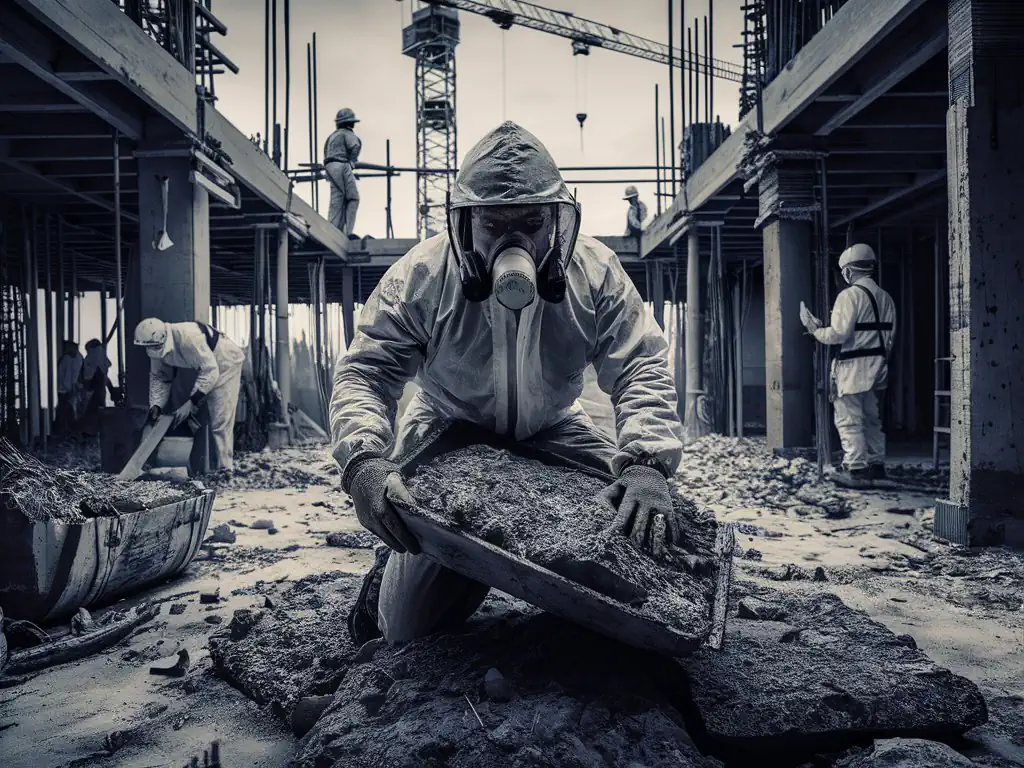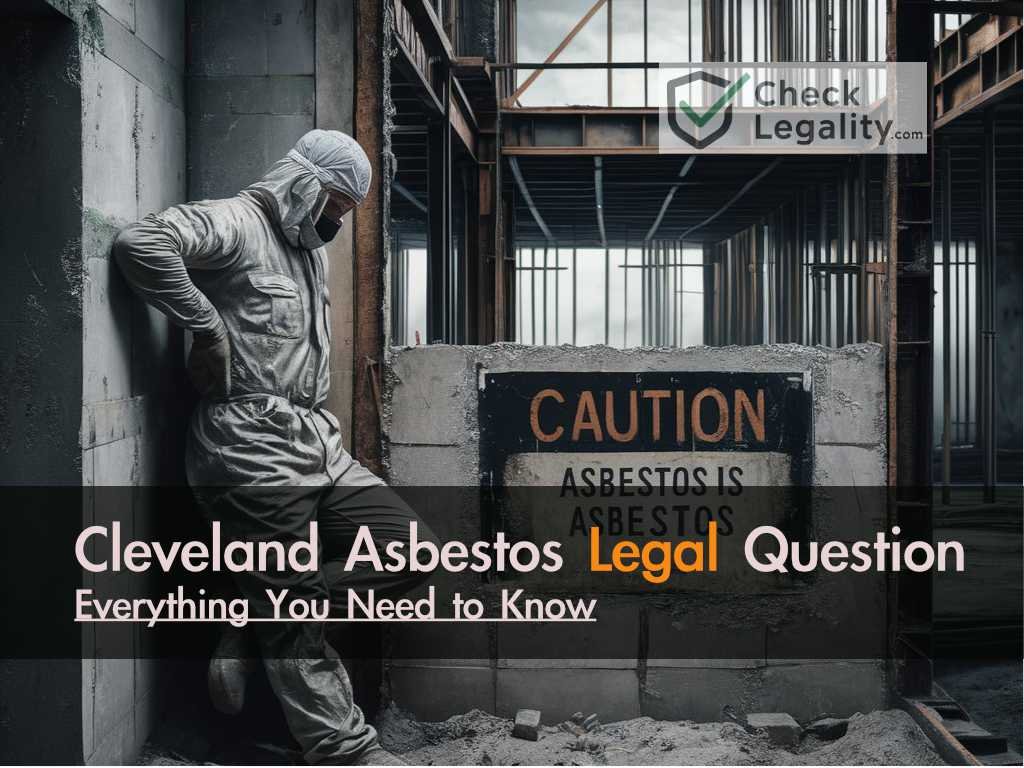In Cleveland, Ohio, an increasing number of people are booking legal appointments for the “Cleveland asbestos legal question,” and this is because of the legacy of industrial prosperity that is overshadowed by the hazardous impact of asbestos used in past decades. As a material once prevalent in construction, manufacturing, and even automotive industries, asbestos poses severe health risks that are only manifesting now among the residents. The “Cleveland asbestos legal question” encapsulates the complex legal landscape surrounding asbestos exposure, highlighting the intricacies of legal claims, liabilities, and the rights of those affected. Navigating this asbestos terrain requires a comprehensive understanding of state and federal laws to address and mitigate these enduring health hazards effectively. This article aims to shed more light on the legal processes involved in asbestos litigation in Cleveland, providing crucial information to empower victims and their families.
Key Takeaways
- Prevalence of Asbestos in Cleveland: Asbestos was extensively used in various industries in Cleveland, increasing health risks to workers and the general public, especially in older buildings and industrial sites.
- Health Risks and Legal Implications: Exposure to asbestos can lead to varying serious diseases such as mesothelioma, asbestosis, and lung cancer, which form the basis of many legal claims in Cleveland.
- Navigating Legal Challenges: Understanding the “Cleveland asbestos legal question” is vital for affected individuals to navigate the complex legal system and pursue justice and compensation.
- Importance of Expert Legal Guidance: Due to the complicated nature of asbestos litigation, consulting with specialized legal professionals is crucial for effectively managing and advancing asbestos-related claims in Cleveland.
- Timeliness is Critical: The statute of limitations for filing asbestos claims in Ohio emphasizes the need for prompt action to secure legal rights and potential compensation.
Asbestos Exposure in Cleveland

Historical Context
Cleveland’s robust industrial history, characterized by heavy manufacturing, construction, and shipbuilding, has left a legacy of asbestos use that persists as a public health concern today. Throughout the mid-20th century, asbestos was favored for its durability and fire-resistant properties, found in everything from factory insulation to residential building materials. However, the extensive use of asbestos has resulted in widespread health issues among residents, manifesting decades after initial exposure.
Affected Locations
Significant asbestos exposure sites in Cleveland include:
- Industrial Facilities: Many of Cleveland’s factories and plants that operated from the early 1900s through the late 1970s utilized asbestos extensively, particularly in high-heat environments.
- Public Buildings and Schools: Buildings constructed before the 1980s, including schools and government buildings, often contain asbestos materials in their structure.
- Residential Areas: Older residential neighborhoods often feature homes built with asbestos-containing materials, particularly in insulation, flooring, and roofing.
Asbestos Legislation
Federal Asbestos Laws
At the federal level, the Environmental Protection Agency (EPA) regulates asbestos through the Asbestos Hazard Emergency Response Act (AHERA) and the Clean Air Act (CAA), which mandate strict protocols for asbestos handling and abatement. These laws aim to protect public health by minimizing airborne asbestos fibers during demolition or renovation activities.
Ohio State Asbestos Regulations
Ohio, similar to New York, Compton, and Columbus, has implemented stringent asbestos regulations enforced by the Ohio Environmental Protection Agency and the Department of Health. These regulations require:
- Notification: Legal obligations to notify state agencies before commencing any project involving asbestos removal.
- Certification: Contractors must obtain proper certification for asbestos abatement to ensure safe handling and disposal practices.
- Safety Protocols: Detailed safety measures must be adhered to, including air quality monitoring and protective gear for workers.
Cleveland Asbestos Legal Questions And Answers
What are the legal steps to take after asbestos exposure?
Immediate steps should include medical consultation to document any health impacts potentially related to asbestos exposure. Legally, it is advisable to consult with a lawyer who specializes in asbestos-related cases to discuss possible claims for compensation.
How does one prove liability in an asbestos-related case?
Proving liability involves proving (with adequate evidence) that the property owner or employer knew about the asbestos risk and neglected to take appropriate safety measures. Essential evidence includes historical building records, medical reports, and expert testimony on asbestos risks.
What types of compensation are available in asbestos lawsuits?
Victims may be eligible for various settings of compensation, including:
- Medical Costs: Covering current and future medical expenses related to asbestos-induced illnesses.
- Lost Wages: Compensation for income lost due to illness.
- Pain and Suffering: Monetary relief for physical and emotional distress.
- Punitive Damages: In cases of egregious negligence, additional compensation may be awarded to punish the wrongdoer.
What is the statute of limitations for filing an asbestos claim in Ohio?
In Ohio, the statute of limitations for asbestos claims is typically two years from the date the disease was diagnosed or should have been diagnosed, highlighting the importance of timely legal action.
Legal Rights and Asbestos in Cleveland
Cleveland residents who may have been exposed to asbestos have specific legal rights designed to protect and compensate them. Understanding these rights is crucial for effectively navigating the legal landscape.
Individual Rights
Individuals exposed to asbestos have the right to:
- Seek Compensation: File claims for damages caused by asbestos exposure, which may include medical bills, lost wages, and pain and suffering.
- Safe Work Environment: Employees have the right to a safe workplace, and employers are obligated to provide proper safety measures against asbestos exposure.
- Legal Action: Pursue lawsuits against manufacturers, employers, and property owners who failed to warn or protect against asbestos hazards adequately.
Community Health Concerns
To protect public health, both federal and state laws have established regulations concerning asbestos:
- Regulations on Asbestos Use: Strict guidelines on how asbestos should be handled, removed, or disturbed during construction or demolition projects.
- Public Access to Information: Laws require that information about asbestos presence and abatement activities be made available to the public to avoid unknowing exposure.
Asbestos Litigation Process in Cleveland
Navigating the asbestos litigation process requires understanding its phases from claim filing to court proceedings. This process is intricate and typically requires the guidance of experienced legal professionals.
Filing a Claim
The first step in initiating asbestos litigation is to file a claim, which includes:
- Documentation: Collecting and presenting proof of asbestos exposure and related health issues.
- Legal Review: A thorough review by legal experts to ensure that all aspects of the case are covered and the claim is within the legal time limits.
Legal Documentation
To support an asbestos claim, the following documentation is typically required:
- Medical Records: Documenting diagnosis and treatments related to asbestos-related diseases.
- Employment History: Proving exposure to asbestos at the workplace.
- Witness Statements: Accounts from co-workers or other relevant parties who can confirm exposure details.
Court Proceedings
The litigation might settle out of court or go to trial, depending on the case’s circumstances:
- Negotiation and Settlement: Most asbestos cases are settled out of court through negotiations between lawyers of both parties.
- Trial: If a settlement cannot be reached, the case may go to trial, where evidence is presented before a judge or jury.
Compensation for Asbestos Victims in Cleveland

Victims of asbestos exposure in Cleveland can pursue various forms of compensation to mitigate the financial and emotional impact of their illnesses.
Types of Compensation Available
- Personal Injury Claims: Victims can file claims against entities that exposed them to asbestos, seeking damages for medical expenses, lost wages, and more.
- Asbestos Trust Funds: Many companies that used asbestos have established trust funds to compensate victims.
- Workers’ Compensation: Employees who were exposed to asbestos at the workplace can claim workers’ compensation benefits, which may cover medical bills and lost wages.
Claim Evaluation Criteria
Evaluating an asbestos claim involves several critical factors that determine eligibility for compensation and the extent of that compensation. It is essential for victims in Cleveland to understand these criteria to effectively prepare their cases.
Criteria for Evaluating Claims
1. Diagnosis of Asbestos-Related Disease:
- A medical professional must have diagnosed the claimant with a disease directly linked to asbestos exposure, such as mesothelioma, asbestosis, or lung cancer.
2. History of Exposure:
- Claimants must demonstrate a clear history of asbestos exposure, detailing when and where the exposure occurred, and under what circumstances.
3. Duration of Exposure:
- The time period over which the claimant was exposed to asbestos can impact the strength of the claim, with prolonged exposure often correlating to a higher likelihood of developing related diseases.
4. Severity of Condition:
- The severity of the claimant’s medical condition and its impact on their quality of life play a crucial role in the compensation process.
5. Statute of Limitations:
- Claims must be filed within a specific timeframe from the diagnosis or discovery of the disease to be considered valid under state law.
Asbestos Legal Resources in Cleveland
Navigating the complex legal landscape of asbestos claims can be challenging. However, several resources in Cleveland are dedicated to assisting victims and their families through this difficult time.
Local Asbestos Law Firms
Some of the most capable law firms specializing in asbestos cases in Cleveland include:
- Smith & Associates: Known for their aggressive representation and deep understanding of asbestos litigation, they have helped many victims secure substantial compensation.
- Johnson Environmental Law Group: With a focus on environmental law, this firm offers expertise in cases where asbestos exposure intersects with broader environmental issues.
Legal Aid and Support Services
- Cleveland Legal Aid Society: This organization provides free legal assistance to those who cannot afford private attorneys. It offers services related to asbestos claims and can help guide victims through the initial stages of filing a claim.
- Asbestos Disease Awareness Organization (ADAO): While not based solely in Cleveland, this national organization offers resources and support for victims across the country, including workshops and advocacy information.
Asbestos Victims Advocacy Groups
- Cleveland Asbestos Support Network: This local group supports and advocates for asbestos victims, organizes meetings, and provides information on the latest treatment options and legal rights.
- National Asbestos Helpline: Offers advice and connects victims with legal and medical resources to help manage their conditions and understand their legal options.
Cleveland Asbestos Legal Question – Case Studies
To better understand the impact of asbestos exposure and the complexities of pursuing legal action, let’s explore several case studies involving individuals and families from Cleveland who have navigated asbestos litigation successfully. These narratives not only illustrate the procedural and emotional journey but also provide real-world outcomes and valuable lessons.
Case Study 1: The Johnson Family
Background: The patriarch of the Johnson family, a former worker at a Cleveland manufacturing plant, developed mesothelioma due to prolonged asbestos exposure.
Legal Journey: The family quickly sought legal assistance upon diagnosis. Their lawyer gathered substantial evidence of the manufacturer’s negligence, including historical safety records and expert medical testimonials.
Outcome: The case was settled out of court within 18 months, providing the family with compensation that covered extensive medical bills, lost wages, and pain and suffering.
Duration: The swift resolution (18 months from filing to settlement) was largely due to the clear evidence of asbestos use and negligence on the part of the employer.
Lessons Learned: The Johnson family’s experience emphasizes the importance of gathering comprehensive evidence and acting quickly after diagnosis.
Case Study 2: Emily Stanton
Background: Emily Stanton, a retired school teacher in Cleveland, was diagnosed with lung cancer linked to indirect asbestos exposure at the school where she had worked.
Legal Journey: Proving her case was challenging due to the indirect nature of exposure. Her legal team spent considerable time collecting all necessary documentation, including building construction records and maintenance logs that confirmed the presence of asbestos.
Outcome: After a prolonged legal battle that lasted nearly five years, Emily won her case, receiving compensation for medical care, pain and suffering, and punitive damages against the school district.
Duration: The case took about five years to resolve, highlighting the potential for extended litigation in instances of indirect exposure.
Lessons Learned: Emily’s prolonged case illustrates the complexities involved in proving indirect asbestos exposure and the critical need for persistent and detailed legal representation.
Case Study 3: Mark Daniels
Background: Mark Daniels, a freelance construction contractor, was exposed to asbestos while renovating older homes in Cleveland. He was later diagnosed with asbestosis.
Legal Journey: Mark’s case was complicated by the fact that his exposure came from multiple sources. His attorneys worked to identify and prove negligence by each source, including tracking down the manufacturers of the asbestos-containing materials.
Outcome: The legal process concluded with a settlement from multiple defendants after four years of intense legal proceedings.
Duration: The entire process, from initial legal consultations to the final settlement, spanned approximately four years.
Lessons Learned: Mark’s experience demonstrates the complexity of cases involving multiple defendants and the importance of a comprehensive evaluation of all potential sources of asbestos exposure.
Conclusion: Cleveland Asbestos Legal Question
Asbestos exposure poses significant health risks, and understanding the “Cleveland asbestos legal question” is essential for affected individuals. Cleveland residents who have been exposed to asbestos should take immediate steps to protect their health and legal rights. This includes consulting with medical professionals, contacting experienced asbestos litigation attorneys, and reaching out to support networks.
If you or a loved one has been affected by asbestos in Cleveland, it is crucial to act swiftly to ensure your rights are protected. Consider reaching out to the resources listed to understand more about your legal options and to potentially secure the compensation you deserve for the hardships endured due to asbestos exposure.
Checklist: Do I Have Potential Asbestos Exposure?
This checklist is designed to help you identify potential asbestos exposure in your environment. Check all that apply:
- Age of Home or Building: My home or workplace was built before 1980.
- Industry: I work in construction, demolition, shipbuilding, heavy industry, or renovation.
- Building Materials: Visible insulation materials, ceiling tiles, floor tiles, pipe cement, and old plaster in my home or workplace.
- State of Repair: There are crumbling, damaged, or water-stained materials in the building.
- Location: I live or work in an area known for historical asbestos use in construction.
- Health Symptoms: I have symptoms such as a persistent cough, shortness of breath, or chest tightness that have no other diagnosed cause.
Interpretation: If you checked two or more of the above, you might be at risk for asbestos exposure. It is recommended to consult with a professional for asbestos testing and medical evaluation.
Quiz: Should I Seek Legal Advice for Asbestos Exposure?
Answer these questions to determine if seeking legal advice might be beneficial for you:
- Have you or someone in your household been diagnosed with an asbestos-related disease?
- Yes
- No
- Do you have a history of working in industries known for asbestos use (e.g., shipbuilding, construction, automotive)?
- Yes
- No
- Have you lived or worked in buildings constructed before 1980?
- Yes
- No
- Are you experiencing health issues that could be linked to long-term asbestos exposure?
- Yes
- No
Results Interpretation:
- Mostly Yes: Strongly consider consulting with an asbestos litigation attorney to discuss your circumstances and potential for a compensation claim.
- Mostly No: While you may not currently need to seek legal advice, stay informed about potential asbestos exposure and related health issues.
Asbestos Exposure Risk Meter
Instructions: Mark the statements that apply to you to calculate your risk level.
- Exposed to environments with known asbestos materials.
- Experiencing respiratory issues without a clear alternative diagnosis.
- Worked in industries with high asbestos usage.
- Building materials at home or work are degrading.
Scoring:
- 0 Checks: Low risk – Regular monitoring and preventative measures are recommended.
- 1-2 Checks: Moderate risk – Consider professional asbestos testing and a medical checkup.
- 3+ Checks: High risk – Immediate action required, including both medical and legal consultations.


